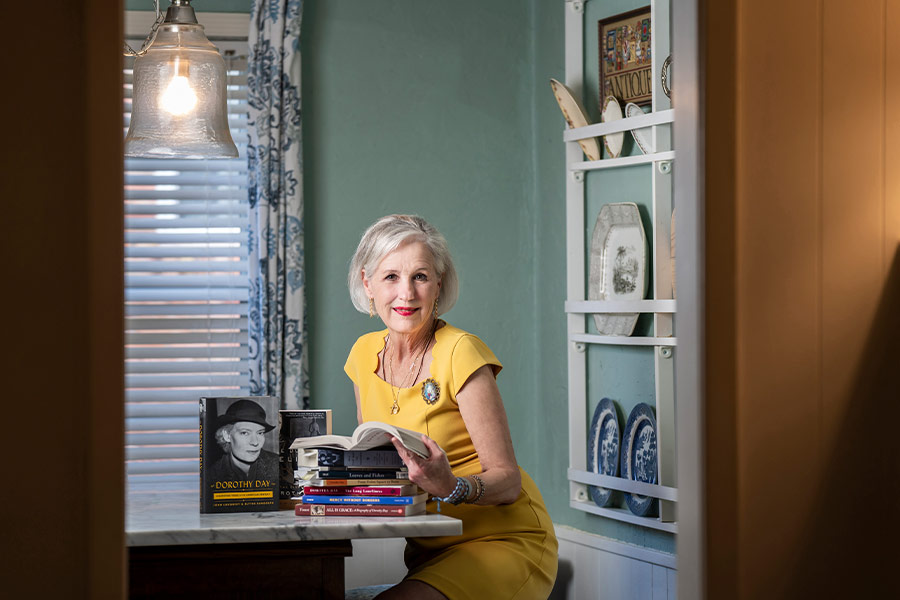Great hardship yields great virtue: Dorothy Day’s path to sainthood began with nursing

Wanda Styrsky poses with books about Dorothy Day at her home in Fort Worth April 29, 2020. (NTC/Juan Guajardo)
FORT WORTH — Whether she’s leading the Rosary before the noon Mass inside St. Patrick Cathedral or from her living room during the coronavirus stay-at-home order, Wanda Styrsky ends the devotion with the same five words — “Dorothy Day, pray for us.”
“People always ask who she is and why we’re praying for her,” explained the staunch advocate for Day’s canonization. “I tell them we’re praying for her because she’s on the path to sainthood. We use her as an intercessor for prayer.”
And never has Dorothy Day’s story of conversion and outreach to the marginalized been more relevant. Best known as co-founder of the Catholic Worker Movement, the native New Yorker was a free-spirited young adult in 1918 — a time of self-discovery that was both complicated yet transformative. One experience in her biography stands out. While working as a newspaper reporter, she socialized with writers, artists, and revolutionaries who gathered in the backroom of the Golden Swan saloon known as the Hell Hole.
During a night of drinking in Greenwich Village, a member of her inner circle, jilted by his girlfriend, intentionally overdosed on heroin.
“Everybody ran but Dorothy and the guy’s sister,” said Jeffry Korgen, the New York-based coordinator of Day’s cause for canonization. “Here were all these people who talked about making the world a better place and when a friend was in trouble, they ran.”
Watching the young man die in her arms transformed Day from an idealist to a realist.
“I hate being Utopian and trying to escape from reality,” she wrote to a friend after the incident. “It’s the poor that are suffering. I’ve got to do something.”
With the Spanish flu raging across the country, the 21-year-old journalist decided to join the nursing staff at Kings County Hospital in Brooklyn. Few people know Day worked as a nurse because it’s not part of her Catholic biography, Korgen pointed out. She didn’t convert to Catholicism until 1927.
But her memories of that short-lived career — recollected in a 1952 autobiography, “The Long Loneliness” — are strikingly similar to what today’s health care workers say about treating coronavirus patients.
“This was the time of the flu epidemic and the wards were full and the halls too,” Day wrote, remembering the long hours and emotionally numbing work in the hospital. “Many of the nurses became ill and we were short-handed.”
At the end of her shift, nurses wrapped bodies in sheets and wheeled them to the morgue. The unceasing flow of patients left no time to dwell on the situation.
“It was impossible to suffer long over the tragedies which took place every day,” she wrote. “One was too close to them to have perspective.”

Day worked as a nurse for a year until the pandemic was over, but the experience left an indelible mark on her soul.
“We see the seeds of who Dorothy Day became in that period,” observed Korgen, who marveled at the way the potential saint could refer to specific memories of specific patients. “The whole idea of personalism — focusing on the person right there in front of you — characterized the Catholic Worker Movement. That’s the heart of Dorothy Day.”
Sara Drury, associate professor of rhetoric at Wabash College, wrote her graduate thesis on Dorothy Day and the Catholic Worker Movement. Growing up in Buffalo, N.Y., she first learned about the social justice reformer at her all-girls Catholic high school.
“One of the things I find remarkable about Dorothy Day was her ability to be incredibly reflective about the world around her,” she asserted. “Her reflection about the current moment always has a link into her past and history. She had empathy for people who were struggling, people who were on the outside of society, and those in great pain or suffering. It would not surprise me if there were strong threads connecting her to being a nurse during the 1918 pandemic.”
Drury, who teaches political discourse and how to have difficult conversations across divides, occasionally offers a course on religious rhetoric. Dorothy Day, who tried to keep a pacifist movement alive in the Catholic Church during the Vietnam War, becomes part of that discussion.
A member of St. Bernard Parish in Crawfordsville, Indiana, the professor is intrigued by the radical acts of love Day and the Catholic Worker community took on.
“They offer a challenge to us,” Drury suggested. “We need to ask ourselves, as a Church, are we really trying to radically love our neighbors? That’s a hard task. Day’s example prompts Catholics today to ask those difficult question about whether we’re living out our faith.”
Styrsky, a former labor and delivery nurse, isn’t surprised Day worked in health care during the 1918 pandemic.
“Nurses are compassionate. They seek to love people and help them in their brokenness,” said the St. Patrick parishioner. “You see in her autobiography her intense desire to help people, and that feeds into where she was led in starting the Catholic Worker Movement.”
Although the world is a different place politically, economically, and medically than it was 100 years ago, there are lessons to glean from Day’s experience during the Spanish flu. Great virtue is formed during great hardship, Styrsky said.
“How many of us, coming out of this hardship, will be formed in great virtue?” she asked. “I think we learn from her what never changes — how to treat other people.”
